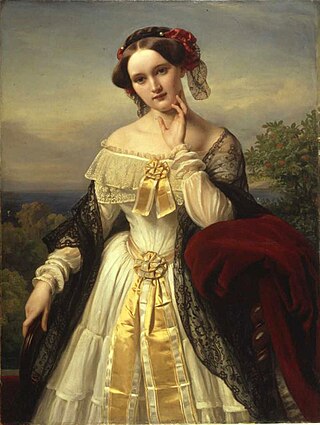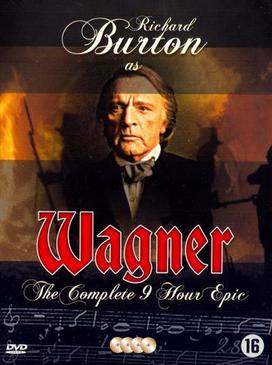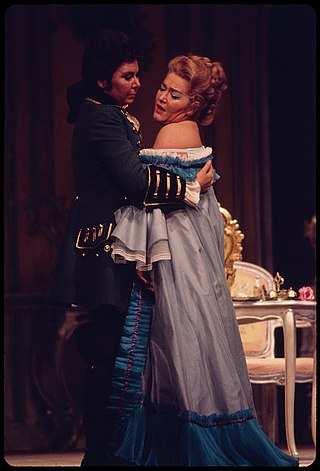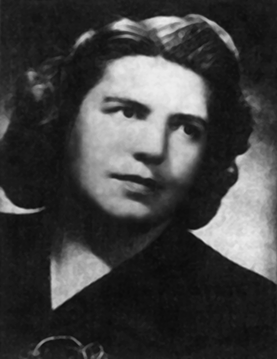
Wilhelm Richard Wagner was a German composer, theatre director, essayist, and conductor who is chiefly known for his operas. Unlike most opera composers, Wagner wrote both the libretto and the music for each of his stage works. Initially establishing his reputation as a composer of works in the romantic vein of Carl Maria von Weber and Giacomo Meyerbeer, Wagner revolutionised opera through his concept of the Gesamtkunstwerk, whereby he sought to synthesise the poetic, visual, musical and dramatic arts, with music subsidiary to drama. The drama was to be presented as a continuously sung narrative, without conventional operatic structures like arias and recitatives. He described this vision in a series of essays published between 1849 and 1852. Wagner realised these ideas most fully in the first half of the 16-hour, four-opera cycle Der Ring des Nibelungen.

Tristan und Isolde, WWV 90, is a music drama in three acts by Richard Wagner set to a German libretto by the composer, loosely based on the medieval 12th-century romance Tristan and Iseult by Gottfried von Strassburg. First conceived in 1854, the music was composed between 1857 and 1859 and premiered at the Königliches Hoftheater und Nationaltheater in Munich on 10 June 1865 with Hans von Bülow conducting. While performed by opera companies, Wagner preferred the term Handlung for Tristan to distinguish its structure of continuous narrative flow as distinct from that of conventional opera at the time which was constructed of mundane recitatives punctuated by showpiece arias, which Wagner had come to regard with great disdain.

Kirsten Malfrid Flagstad was a Norwegian opera singer, who was the outstanding Wagnerian soprano of her era. Her triumphant debut in New York on 2 February 1935 is one of the legends of opera. Giulio Gatti-Casazza, the longstanding General Manager of the Metropolitan Opera said, “I have given America two great gifts — Caruso and Flagstad.”

Wesendonck Lieder, WWV 91, is the common name of a set of five songs for female voice and piano by Richard Wagner, Fünf Gedichte für eine Frauenstimme. He set five poems by Mathilde Wesendonck while he was working on his opera Tristan und Isolde. The songs, together with the Siegfried Idyll, are the two non-operatic works by Wagner most regularly performed.

Fire and Sword is a 1981 romantic drama film directed by Veith von Fürstenberg. It is based on the legend of Tristan and Isolde, played by Christoph Waltz and Antonia Preser. Leigh Lawson and Peter Firth also star. Set during a raging war between Cornwall and Ireland, the film explores themes on conflict between magic and religion, violence, and destruction.

Max Lorenz was a German heldentenor famous for Wagnerian roles.

Ludwig Schnorr von Carolsfeld was a German heldentenor. The son of painter Julius Schnorr von Carolsfeld, he was trained as a vocalist at the Kreuzschule in Dresden and the Leipzig Conservatory. He was a resident artist at the Karlsruhe Hofoper from 1854-1860, and the Semperoper in Dresden from 1860-1865.
Christine Brewer is an American soprano opera singer.

Wagner is a 1983 television miniseries on the life of Richard Wagner with Richard Burton in the title role. It was directed by Tony Palmer and written by Charles Wood. The film was later released on DVD as a ten-part miniseries.
This is an audio and video discography of Tristan und Isolde, an opera by Richard Wagner which was first performed on 10 June 1865 in Munich.

Johanna Meier is an American operatic soprano. She has been described as "one of the foremost Wagnerian sopranos of her era". She had an international career, including fourteen years at the Metropolitan Opera and three summers singing the role of Isolde in Wagner's Tristan und Isolde for the Bayreuth Festival—the Festival's first American Isolde.

Wagner e Venezia is a live album by pianist Uri Caine's Ensemble featuring compositions by Richard Wagner recorded in Venice and released on the Winter & Winter label in 1997.
Ingrid Haubold is a German operatic soprano. After beginning her career in Munich and continuing with German companies, she moved on to major international opera houses, appearing as Isolde in Wagner's Tristan und Isolde at the Teatro Real in Madrid in 1986, as Senta in Der fliegende Holländer at the Savonlinna Opera Festival, and in the title role of Beethoven's Fidelio at the Metropolitan Opera in New York City.

Ruth Hesse was a German opera singer. A dramatic mezzo-soprano, she was a member of the Deutsche Oper Berlin from 1962 to 1995, where she took part in the world premiere of Henze's Der junge Lord. She was first invited to the Bayreuth Festival in 1960, where she performed until 1979.

Kii-Ming Lo, born November 4, 1954, in Keelung, is a Taiwanese musicologist.
Margarete Henriette Therese Roßkopf-Bäumer was a German operatic soprano.

Enid Szánthó was a Hungarian operatic contralto. From 1928, she belonged to the ensemble of the Vienna State Opera and appeared at the Bayreuth Festival from 1930, first as Erda in Der Ring des Nibelungen. She gave guest performances in opera and concert in Florence, London, Berlin, Paris, and New York at the Metropolitan Opera, where she made her debut as Fricka in 1938. Her career was de facto ended later that year when Austria came under the Nazi regime.

Tristan and Isolde is the title of two oil paintings by the Spanish artist Rogelio de Egusquiza. Both works are based on the opera Tristan und Isolde by the German composer Richard Wagner, whom Egusquiza idolised. The first painting, subtitled Death and also known as La mort d'Isolde, was completed in 1910 and depicts Isolde's "Liebestod", as she collapses in death upon the lifeless body of Tristan. The second painting, subtitled Life, was completed two years later and depicts the lovers embracing in the night, a scene from the second act of Wagner's opera.

Helena Braun was a German dramatic soprano. She made her stage debut in Mozart's Le nozze di Figaro in 1928 and joined the Vienna State Opera and the Bavarian State Opera in 1939 and 1940, respectively. She became known for Wagnerian roles such as Brünnhilde in Der Ring des Nibelungen and Ortrud in Lohengrin.















